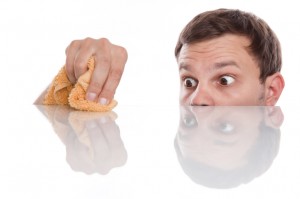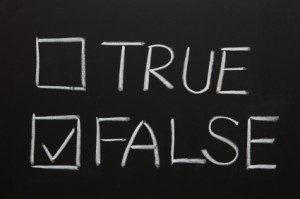Have We Got It All Backwards?

Don’t shoot!
The concept of cause-and-effect is very slippery. We think that A causes B only to find that C really causes both A and B. Or, perhaps it’s really B that causes A. More subtly, A might influence B which turns right around and influences A.
Lately, I’ve been thinking that we’ve been looking at a lot of things from the wrong end of the telescope. Some examples:
Our brain creates us – what creates our personality and the essence of who we are? Why our brains, of course. My brain is the cause; my personality is the effect. Further, the brain is what it is; there’s not much we can do about it. Well…not so fast. Maybe we got it backwards. It turns out that the brain is plastic; we can change it through our habits, actions, and thoughts. In many ways, we create our brains rather than the other way round. Norman Doidge is a leading writer on brain plasticity. You can find his books here and here.
Mutate first; adapt later – our general model of evolution suggests that random mutations happen in our DNA. Mutations that provide a competitive edge are then preserved and passed on. Mutations that aren’t so helpful just fade away. But, according to a recent article in New Scientist, we may have it backwards. Again, plasticity is a key concept. “A growing number of biologists think … plasticity may also play a key role in evolution. Instead of mutating first and adapting later, they argue, animals often adapt first and mutate later.”
I am the master of my fate – I used to believe that I was in control. Now I realize that my System 1 often makes decisions without any input from “me”. Indeed, I don’t even know the decisions are being made. But it’s not just my “primitive brain” that molds my behavior. It’s also how fast my heart beats and how healthy my vagus nerve is. But it’s not even just my body that steers me. It’s also the microbes in my gut. When the microbes team up, they can make me do bizarre things – like eating chocolate. They may even contribute to schizophrenia.
OCD starts with thoughts – we’ve always assumed that irrational thoughts create obsessive compulsive disorder. Irrational thoughts begin in the brain and radiate outward to produce irrational behavior. But, as Clare Gillan points out, we may have it backwards. When she induced new habits in volunteers, she found that people with OCD change their beliefs to explain the new habit. In other words, behavior is the cause and belief is the effect.
The gardener manages the garden – Suellen loves to garden and will spend hours at hard labor under a hot sun. When I see how hard she works, I wonder if she’s managing the flowers or if they’re managing her. It’s not a new thought. The Botany of Desire makes the same point.
What else have we gotten backwards? It’s hard to know. But, as the Heath brothers point out in Decisive, if you believe A causes B, you owe it to yourself to consider the opposite.
The Doctor Won’t See You Now

Shouldn’t you be at a meeting?
If you were to have major heart problem – acute myocardial infarction, heart failure, or cardiac arrest — which of the following conditions would you prefer?
Scenario A — the failure occurs during the heavily attended annual meeting of the American Heart Association when thousands of cardiologists are away from their offices or;
Scenario B — the failure occurs during a time when there are no national cardiology meetings and fewer cardiologists are away from their offices.
If you’re like me, you’ll probably pick Scenario B. If I go into cardiac arrest, I’d like to know that the best cardiologists are available nearby. If they’re off gallivanting at some meeting, they’re useless to me.
But we might be wrong. According to a study published in JAMA Internal Medicine (December 22, 2014), outcomes are generally better under Scenario A.
The study, led by Anupam B. Jena, looked at some 208,000 heart incidents that required hospitalization from 2002 to 2011. Of these, slightly more than 29,000 patients were hospitalized during national meetings. Almost 179,000 patients were hospitalized during times when no national meetings were in session.
And how did they fare? The study asked two key questions: 1) how many of these patients died within 30 days of the incident? and; 2) were there differences between the two groups? Here are the results:
- Heart failure – statistically significant differences – 17.5% of heart failure patients in Scenario A died within 30 days versus 24.8% in Scenario B. The probability of this happening by chance is less than 0.1%.
- Cardiac arrest — statistically significant differences – 59.1% of cardiac arrest patients in Scenario A died within 30 days versus 69.4% in Scenario B. The probability of this happening by chance is less than 1.0%.
- Acute myocardial infarction – no statistically significant differences between the two groups. (There were differences but they may have been caused by chance).
The general conclusion: “High-risk patients with heart failure and cardiac arrest hospitalized in teaching hospitals had lower 30-day mortality when admitted during dates of national cardiology meetings.”
It’s an interesting study but how do we interpret it? Here are a few observations:
- It’s not an experiment – we can only demonstrate cause-and-effect using an experimental method with random assignment. But that’s impossible in this case. The study certainly demonstrates a correlation but doesn’t tell us what caused what. We can make educated guesses, of course, but we have to remember that we’re guessing.
- The differences are fairly small – we often misinterpret the meaning of “statistically significant”. It sounds like we found big differences between A and B; the differences, after all, are “significant”. But the term refers to probability not the degree of difference. In this case, we’re 99.9% sure that the differences in the heart failure groups were not caused by chance. Similarly, we’re 99% sure that the differences in the cardiac arrest groups were not caused by chance. But the differences themselves were fairly small.
- The best guess is overtreatment – what causes these differences? The best guess seems to be that cardiologists – when they’re not off at some meeting – are “overly aggressive” in their treatments. The New York Times quotes Anupam Jena: “…we should not assume … that more is better. That may not be the case.” Remember, however, that this is just a guess. We haven’t proven that overtreatment is the culprit.
It’s a good study with interesting findings. But what should we do about them? Should cardiologists change their behavior based on this study? Translating a study’s findings into policies and protocols is a big jump. We’re moving from the scientific to the political. We need a heavy dose of critical thinking. What would you do?
Effect and Cause

Is it clean yet?
I worry about cause and effect. If you get them backwards, you wind up chasing your tail. While you’re at it, you can create all kinds of havoc.
Take MS (please). We have long thought of multiple sclerosis as an autoimmune disease. The immune system interprets myelin – the fatty sheath around our nerves – as a threat and attacks it. As it eats away the myelin, it also impairs our ability to send signals from our brain to our limbs. The end result is often spasticity or even paralysis.
We don’t know the cause but the effect is clearly the malfunctioning immune system. Or maybe not. Some recent research suggests that a bacterium may be involved. It may be that the immune system is reacting appropriately to an infection. The myelin is simply an innocent bystander, collateral damage in the antibacterial attack.
The bacterium involved is a weird little thing. It’s difficult to spot. But it’s especially difficult to spot if you’re not looking for it. We may have gotten cause and effect reversed and been looking for a cure in all the wrong places. If so, it’s a failure of imagination as much as a failure of research. (Note that the bacterial findings are very preliminary, so let’s continue to keep our imaginations open).
Here’s another example: obsessive compulsive disorder. In a recent article, Claire Gillan argues that we may have gotten cause and effect reversed. She summarizes her thesis in two simple sentences: “Everybody knows that thoughts cause actions which cause habits. What if this is the wrong way round?”
As Gillan notes, we’ve always assumed that OCD behaviors were the effect. It seemed obvious that the cause was irrational thinking and, especially, fear. We’re afraid of germs and, therefore, we wash our hands obsessively. We’re afraid of breaking our mother’s back and, therefore, we avoid cracks in the sidewalk. Sometimes our fears are rooted in reality. At other times, they’re completely delusional. Whether real or delusional, however, we’ve always assumed that our fears caused our behavior, not the other way round.
In her research on OCD behavior, Gillan has made some surprising discoveries. When she induced new habits in volunteers, she found that people with OCD change their beliefs to explain the new habit. In other words, behavior is the cause and belief is the effect.
Traditional therapies for OCD have sought to address the fear. They aimed to change the way people with OCD think. But perhaps traditional therapists need to change their own thinking. Perhaps by changing the behaviors of people with OCD, their thinking would (fairly naturally) change on its own.
This is, of course, quite similar to the idea of confabulation. With confabulation, we make up stories to explain the world around us. It gives us a sense of control. With OCD – if Gillan is right – we make up stories to explain our own behavior. This, too, gives us a sense of control.
Now, if we could just get cause and effect straight, perhaps we really would have some control.
How Do You Know If Something Is True?
 I used to teach research methods. Now I teach critical thinking. Research is about creating knowledge. Critical thinking is about assessing knowledge. In research methods, the goal is to create well-designed studies that allow us to determine whether something is true or not. A well-designed study, even if it finds that something is not true, adds to our knowledge. A poorly designed study adds nothing. The emphasis is on design.
I used to teach research methods. Now I teach critical thinking. Research is about creating knowledge. Critical thinking is about assessing knowledge. In research methods, the goal is to create well-designed studies that allow us to determine whether something is true or not. A well-designed study, even if it finds that something is not true, adds to our knowledge. A poorly designed study adds nothing. The emphasis is on design.
In critical thinking, the emphasis is on assessment. We seek to sort out what is true, not true, or not proven in our info-sphere. To succeed, we need to understand research design. We also need to understand the logic of critical thinking — a stepwise progression through which we can discover fallacies and biases and self-serving arguments. It takes time. In fact, the first rule I teach is “Slow down. Take your time. Ask questions. Don’t jump to conclusions.”
In both research and critical thinking, a key question is: how do we know if something is true? Further, how do we know if we’re being fair minded and objective in making such an assessment? We discuss levels of evidence that are independent of our subjective experience. Over the years, thinkers have used a number of different schemes to categorize evidence and evaluate its quality. Today, the research world seems to be coalescing around a classification of evidence that has been evolving since the early 1990s as part of the movement toward evidence-based medicine (EBM).
The classification scheme (typically) has four levels, with 4 being the weakest and 1 being the strongest. From weakest to strongest, here they are:
- 4 — evidence from a panel of experts. There are certain rules about such panels, the most important of which is that it consists of more than one person. Category IV may also contain what are known as observational studies without controls.
- 3 — evidence from case studies, observed correlations, and comparative studies. (It’s interesting to me that many of our business schools build their curricula around case studies — fairly weak evidence. I wonder if you can’t find a case to prove almost any point.)
- 2 — quasi-experiments — well-designed but non-randomized controlled trials. You manipulate the independent variable in at least two groups (control and experimental). That’s a good step forward. Since subjects are not randomly assigned, however, a hidden variable could be the cause of any differences found — rather than the independent variable.
- 1b — experiments — controlled trials with randomly assigned subjects. Random assignment isolates the independent variable. Any effects found must be caused by the independent variable. This is the minimum proof of cause and effect.
- 1a — meta-analysis of experiments. Meta-analysis is simply research on research. Let’s say that researchers in your field have conducted thousands of experiments on the effects of using electronic calculators to teach arithmetic to primary school students. Each experiment is data point in a meta-analysis. You categorize all the studies and find that an overwhelming majority showed positive effects. This is the most powerful argument for cause-and-effect.
You might keep this guide in mind as you read your daily newspaper. Much of the “evidence” that’s presented in the media today doesn’t even reach the minimum standards of Level 4. It’s simply opinion. Stating opinions is fine, as long as we understand that they don’t qualify as credible evidence.
Does Smoking Cause Cancer in Humans?

You can’t prove nothing.
Let’s do an experiment. We’ll randomly select 50,000 people from around the United States. Then we’ll assign them — also randomly — to two groups of 25,000 each. Let’s call them Groups X and Y. We’ll require that every member of Group X must smoke at least three packs of cigarettes per day. Members of Group Y, on the other hand, must never smoke or even be exposed to second hand smoke. We’ll follow the two groups for 25 years and monitor their health. We’ll then announce the results and advise people on the health implications of smoking.
I’ve just described a pretty good experiment. We manipulate the independent variable — in this case, smoking — to identify how it affects the dependent variable — in this case, personal health. We randomize the two groups so we’re sure that there’s no hidden variable. If we find that X influences Y, we can be sure that it’s cause and effect. It can’t be that Y causes X. Nor can it be that Z causes both X and Y. It has to be that X causes Y. There’s no other explanation.
The experimental method is the gold standard of causation. It’s the only way to prove cause and effect beyond a shadow of a doubt. Yet, it’s also a very difficult standard to implement. Especially in cases involving humans, the ethical questions often prevent a true experimental method. Could we really do the experiment I described above? Would you be willing to be assigned to Group X?
The absence of good experiments can confuse our public policy. For many years, the tobacco industry claimed that no one had ever conclusively proven that smoking caused cancer in humans. That’s because we couldn’t ethically run experiments on humans. We could show a correlation between smoking and cancer. But the tobacco industry claimed that correlation is not causation. There could be some hidden variable, Z, that caused people to take up smoking and also caused cancer. Smoking is voluntary; it’s a self-selected group. It could be — the industry argued — that whatever caused you to choose to smoke also caused your cancer.
While we couldn’t run experiments on humans, we did run experiments on animals. We did essentially what I described above but substituted animals for humans. We proved — beyond a shadow of a doubt — that smoking caused cancer in animals. The tobacco industry replied that animals are different from humans and, therefore, we had proven nothing about human health.
Technically, the tobacco industry was right. Correlation doesn’t prove causation. Animal studies don’t prove that the same effects will occur in humans. For years, the tobacco industry gave smokers an excuse: nobody has ever proven that smoking causes cancer.
Yet, in my humble opinion, the evidence is overwhelming that smoking causes cancer in humans. Given the massive settlements of the past 20 years, apparently the courts agree with me. That raises an intriguing question: what are the rules of evidence when we can’t run an experiment? When we can’t run an experiment to show that X causes Y, how do we gather data — and how much data do we need to gather — to decide policy and business issues? We may not be able to prove something beyond a shadow of a doubt, but are there common sense rules that allow us to make common sense decisions? I can’t answer all these questions today but, for me, these questions are the essence of critical thinking. I’ll be writing about them a lot in the coming months.
